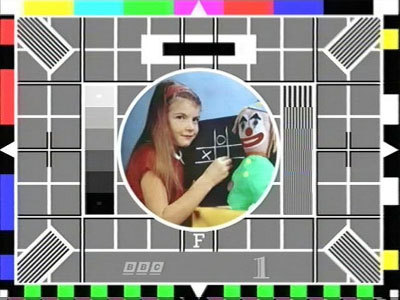
When Brits of a certain age imagine snapping on the telly, they find Test Card F burned into their retinas. An irregular grid of gray-and-white squares, each corner bisected at the diagonal with bold stripes. In the center floats a circle that, fish-eye-like, reveals a scene begging for explanation: a little girl in an Alice hairband plays tic-tac-toe (or, to use the game’s British name, “noughts and crosses”) with a hideous clown doll. Transmitted late nights and during the workday, Test Card F ruled off-hours BBC television from 1967 to 1998, dwindled rapidly into non-existence with the rise of 24-hour programming. The girl and clown have been locked in a “never-ending game… reminiscent of the feudal knight taking on Death at chess in Ingmar Bergman’s The Seventh Seal” for over 70,000 hours, making Test Card F the longest-running TV broadcast in British history.
I stumbled on this enigmatic image while writing my latest book Patternalia: An Unconventional History of Polka Dots, Stripes, Plaid, Camouflage, & Other Graphic Patterns. It fell outside my research focus—the book decodes the cultural histories of graphic patterns across the globe—but grabbed firmly onto my lapels and held. Patternalia started with an irrational, but persistent observation I had: why do we imbue individual patterns with a sense of personality? Why should polka dots seem demure and female, or Hawaiian-prints obnoxious and boorish, or stripes speedy and decisive? Writing this book was all about taking that nutso question seriously, and tracking down some definitive answers.
While Test Card F isn’t, strictly speaking, a graphic pattern in the tradition of plaid or fleur de lis, it’s absolutely earned its place in the pantheon of repeated imagery in daily life that’s too often ignored. “The ephemeral is not the opposite of the eternal,” art critic John Berger wrote in his 2008 book From A to X: A Story in Letters. “The opposite of the eternal is the forgotten.” For millions of Britons in the heart of the previous century, Test Card F papered hours and days and years with the same inscrutable picture. I conjure it up in my mind’s eye: a square of cracklingly live wallpaper you could switch on and off, the telly’s default image, the ghostly underside of all programming. Its intermittent visiblity probably wouldn’t have diminished how enveloping and endless it felt—just like any fascinating wallpaper.
This mesmerizing image rewards parsing. Created by former BBC engineer George Hersee, his 2001 BBC obituary explains the technological moment that gave rise to Test Card F: Prior to color televisions, TV installers made do with scientifically abstracted testcards to refine reception. But “colour TV presented new problems,” writes...
You have reached your article limit
Sign up for a digital subscription and continue reading all new issues, plus our entire archives, for just $1.50/month.
Already a subscriber? Sign in




